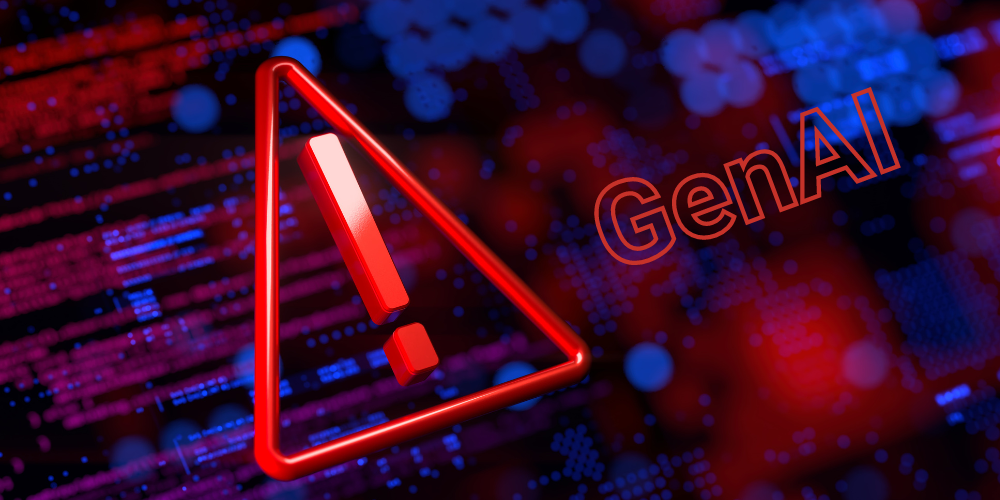GenAI – throwing caution to the winds
by Peter Silva
Posted on November 7, 2023
Want to interview Peter?
Contact
Rapid GenAI Adoption is Unhampered by IT Concerns
Generative AI (GenAI) is being adopted by the corporate world at breakneck speed, much faster than other new technologies, such as blockchain, have been in the past. Everyone is racing to figure out how GenAI will impact their businesses and their way of doing business, and how they can leverage it to improve performance productivity and customer satisfaction.
Yet along with the enthusiasm about GenAI, a recent survey of 1,000 IT decision makers revealed that virtually everyone – 99% of those who have started to adopt this new technology — has issues and concerns with the technology.
A new report from TECHnalysis Research highlights those concerns.
The Problems with GenAI
In a previous post about GenAI, we talked about some of the business uses for GenAI as well as some of the potential hazards. The new report provides interesting data on both the rate of adoption of this new technology, and the issues that worry IT decision makers.
Almost all companies surveyed (88%) are already using the technology. Yet only 7% of the companies have any kind of formal policy regarding usage of GenAI. While very many companies are using GenAI, even more – 95% – believe it will or possibly could have a profound impact on work. No wonder everyone wants to jump on board quickly. No one wants to be left behind.
There is, however, a real “fear factor” in place for IT professionals. Companies are jumping in with both feet, yet by their own admission, they lack understanding of the risks involved.
The biggest single concern among companies responding to the survey is around security and data protection. That’s also one of the top reasons that companies which are not using the technology have not yet adopted it. In addition, they have many concerns regarding the output of these tools, including inaccuracies, bias, lack of watermarking (both to identify the work as created by AI and to protect IP), and inability to verify the output.
Knowledgeable Users and Policies
We can reasonably assume that one reason only 7% of companies have policies on GenAI usage is that the technology is so new that the risks are not fully understood by management, much less how those still-murky risks should be mitigated.
Many of the risks associated with using GenAI can be mitigated immediately through responsible use. For instance, since the technology is known to generate inaccuracies, bias, and in some cases complete “hallucinations,” usage could be limited to users who have been trained to spot them and can be trusted to carefully vet all GenAI output.
Users can also be instructed not to enter proprietary or personally identifiable information into these tools to prevent data loss. But as phishing education has amply demonstrated, users often forget or disregard instructions and cautions when immersed in getting tasks done. Just as browser isolation provides protections against phishing, even when users click, technology tools can provide more reliable safeguards against risky GenAI use than merely relying on users to absorb and apply the risk-reduction instructions they’ve received.
Technological Tools for Safe Usage of GenAI
The dangers associated with GenAI are what led us to develop Ericom Generative AI Isolation. Generative AI Isolation allows companies to safely allow GenAI use even in these early days, when companies and users are still exploring how to use the new technology without risking their data or their integrity.
With Generative AI Isolation, users accessing GenAI tools such as ChatGPT do so via isolated containers in the Ericom Cloud. Users interact with GenAI sites in a completely normal fashion. However, as interactions run through Ericom airgaps, policy-based security controls are applied to prevent data loss (DLP), restrict data sharing, and limit who can use GenAI tools and how they can use them. Users are unable to enter PII or other sensitive information into the GenAI app, protecting companies from liability for exposing personal information and keeping their IP secure.
As an isolation technology, Ericom GenAI isolation also protects user devices and enterprise networks from any malware that the GenAI tool may have originated or might be passing on from a malicious source.
Conclusion
GenAI is being adopted by the corporate world seemingly overnight, despite the many valid concerns IT managers have about data leakage, protection of IP, copyright, and inaccurate or biased information – as well as concerns that may not yet have surfaced.
There is almost universal agreement that GenAI will have a major impact on the business world. Companies that put policies and technological protections such as Ericom Generative AI Isolation in place will benefit by being able to quickly leverage the full power and efficiencies of Generative AI while avoiding exposure to known and as-yet-unknown hazards.
About Peter Silva
Peter Silva is the Sr. Product Marketing Manager at Ericom, the Cybersecurity Unit of Cradlepoint. After a decade working in the professional theater, he became one of the first 6 Internet Specialists at AT&T, focusing on access and security. Over the years, he’s been recognized for his stellar record of captivating audiences with engaging presentations and high-quality content. Along with AT&T, he’s held positions at Verio, Exodus, Pacific Wireless Corp and F5.Recent Posts

Air Gapping Your Way to Cyber Safety
Physically air gapping enterprise networks from the web is a great way to protect operations, keep data safe … and squelch productivity. Virtual air gapping is a better approach.

Motion Picture Association Updates Cybersecurity Best Practices
The MPA recently revised its content security best practices to address, among other challenges, the issue of data protection in the cloud computing age.

FTC Issues Cybersecurity Warning for QR Codes
QR codes on ads are a simple way to grab potential customers before they move on. No wonder cybercriminals are using QR codes, too.